The Getty Center and Griffith Observatory in Los Angeles
Posted on Aug 27, 2012 in category
The Getty Center's largely 14,000 tonnes of Italian travertine construction fits snuggly, yet profoundly, onto one of the hilltops of Santa Monica Mountains allowing visitors to look out over the spread-eagled city of Los Angeles. After thirteen years of planning and construction (the Parthenon took 15 years; the Sydney Opera House 16 years!), the 36 hectares iconic site opened to the public in 1997. Within this culture-lovers' campus there is the J.P. Getty Museum, the Getty Research Institute, Getty Foundation, Getty Conservation Institute and J.P. Getty Trust administration offices.
Architect Richard Meier masterly used the vertices of the ridges to position curvilinear design elements into the two main outstretched-arms-like stone edifices, the East and West Pavilions, whilst weaving courtyards, terraces and gardens among and around them.
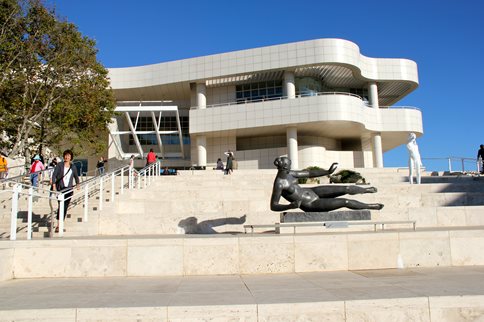
An 'Arrival Plaza' to remember with French sculptor, Aristide Maillol's 'Air ' in pride of horizontal place but with the Museum's curves adding to the beauty of the spatial moment. A free and pleasurable 5 minute cushion-of-air ride in an electric cable-driven tram preceded our arrival to the summit site.
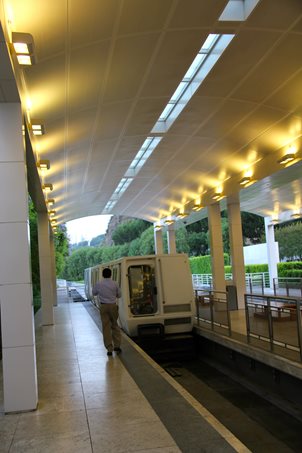
'All aboard!' at the Lower Tram station to experience what Richard Meier described as, "being elevated out of their [visitors] day-to-day experience".
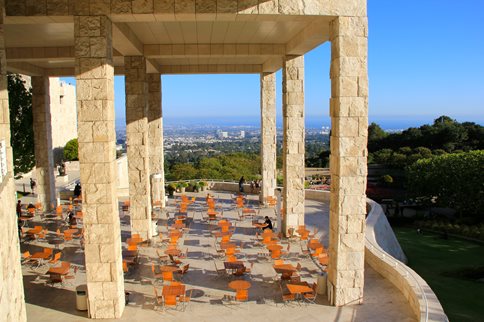
How is this for a view from the Garden Terrace Cafe? Robert Irwin created the Central Garden's maze feature with some 400 azalea plants creating a sculpture in its own right.
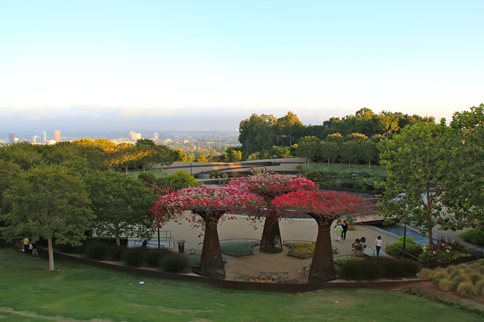
Another view of the Central Garden which is part of a water saving scheme that has cut water use by 30%. Energy consumption is down too in the Getty Centre by 10%. Skylights that utilise natural light, computer-controlled louvres that regulate that natural light and energy-saving lighting have combined to make the Getty Centre a leader in energy and environmental civic architectural design.
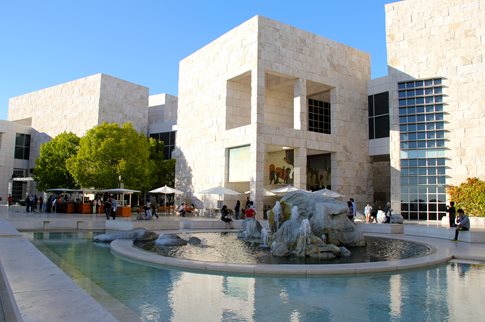
Blue-veined marble boulders are a focal point in the Museum Courtyard Fountain which highlights the boldly constructed travertine wall blocks from Bagni di Tivoli in Italy. A visual impact with 'no compromise'!
The Getty Center's Museum is an art gallery based on a core of John Paul Getty's original collection of decorative arts and sculpture. His passion for classical themes is evident among the collection.
J.P.Getty did collect some paintings namely Italian Renaissance and European Baroque. The Mueum has extended the collection to include Dutch and French Schools including Impressionists and Post Impressionists. Van Gogh's 1889 'Irises' is an important part of this collection. Van Gogh created this painting along with 129 others in the last year of his life whilst living in an asylum at Saint Remy-en-Provence. Van Gogh had to endure cold water bath therapy in a vain bid to overcome his 'illness'.
Van Gogh's 'Irises'
This painting was purchased from Alan Bond who paid a record $54 million for it in 1987; but, the deal with the Getty Center remained confidential. Van Gogh like many artists were influenced by Japanese woodblock prints - note the bold, black outlines around the irises!
Danish artist, Christen Kobke, visited Pompeii in 1840 culminating the following year with this studio oil painting of the forum with its nemesis, Mount Vesuvius, omnipresent. Note the goats grazing closeto the Capitoline Temple's foundations and, of course, one of the curses of archaeology at Pompeii - WEEDS!
The forum of Pompeii (1841)
Another benefactor of Los Angeles was Colonel Griffith J. Griffith, a mining and real estate tycoon, who was impressed by Europe's great cities' parks; consequently, in the year 1896 he donated over 1000 hectares to the city of Los Angeles. The city's leaders who represented 100,000 citizens were at first hesistant to accept so much land outside the city's limits. Today over 10 million people live in Los Angeles and Griffith Park is central and accessible to all citizens. Additionally, in 1912 Griffith J. Griffith offerred to build a public observatory in the park. His death seven years later did not end his vision for he left funds to build both an observatory and a Greek theatre nearby. Only in 1933 did authorities begin the venture taking only two years to finish. Interestingly, World War 2 pilots trained to fly by the stars at the Observatory and Apollo astronauts between 1966-67 also trained here to navigate by the stars. Science exhibits are also on display as well as the updated planetarium which I thought was a little too influenced by Hollywood 'starry' drama and hollowness.

A four year renovation (2002-2006) ensures that Griffith Observatory will continue to give the public access to future astronomical events.

The Apollo astronauts' six missions to the moon allowed scientists to examine over 381 kilograms of rocks, pebbles, dust and core samples. The biggest rock 'Big Bertha' weighed nearly 9 kilograms and was temporarily on display at Griffith Observatory. Above is a smaller rock sample believed to be closely related to earth in that the moon may have evolved from another object's collision with earth.